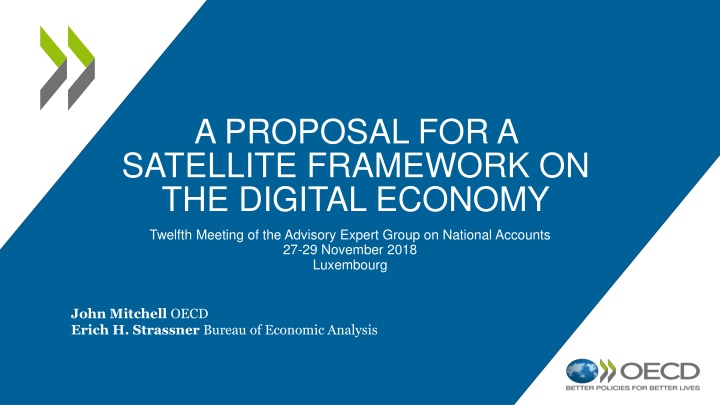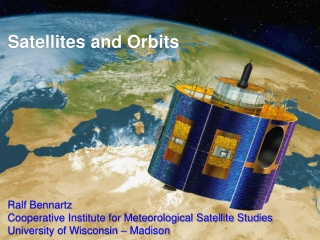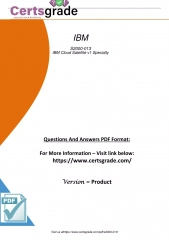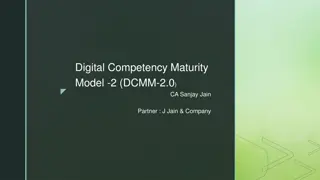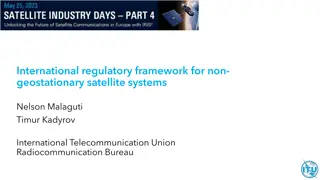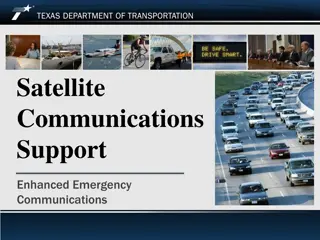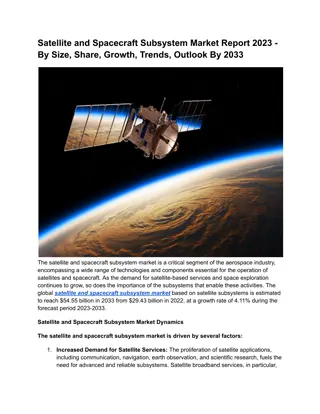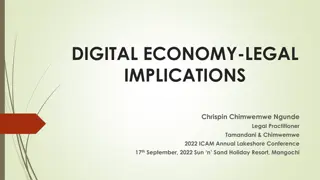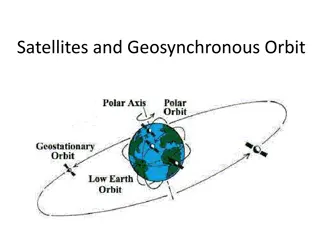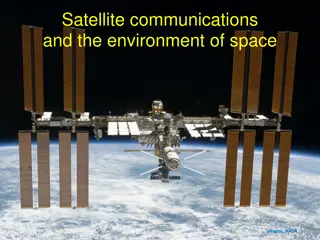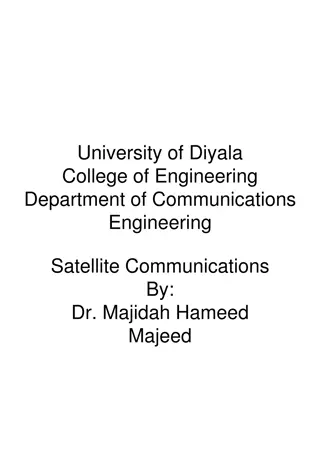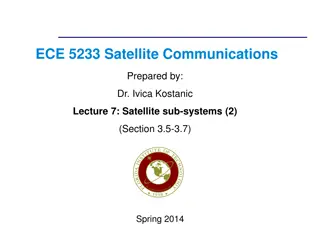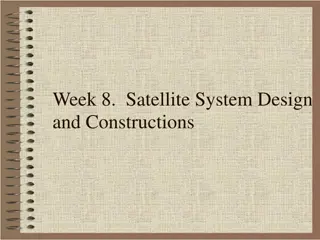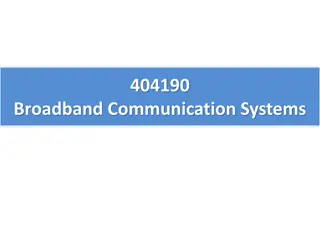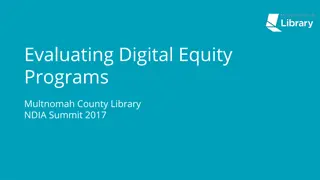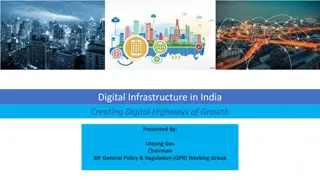Proposal for a Satellite Framework on the Digital Economy
In-depth analysis of a proposed satellite framework for the digital economy, focusing on supply-use tables, definitions, and indicators for measuring digitally-enabled industries. Includes background information, outlines, and examples to enhance understanding and implementation within existing statistical frameworks.
Uploaded on Feb 23, 2025 | 1 Views
Download Presentation

Please find below an Image/Link to download the presentation.
The content on the website is provided AS IS for your information and personal use only. It may not be sold, licensed, or shared on other websites without obtaining consent from the author.If you encounter any issues during the download, it is possible that the publisher has removed the file from their server.
You are allowed to download the files provided on this website for personal or commercial use, subject to the condition that they are used lawfully. All files are the property of their respective owners.
The content on the website is provided AS IS for your information and personal use only. It may not be sold, licensed, or shared on other websites without obtaining consent from the author.
E N D
Presentation Transcript
A PROPOSAL FOR A SATELLITE FRAMEWORK ON THE DIGITAL ECONOMY Twelfth Meeting of the Advisory Expert Group on National Accounts 27-29 November 2018 Luxembourg John Mitchell OECD Erich H. Strassner Bureau of Economic Analysis
Supply-Use Tables for the Digital Economy 1) Present some background 2) Provide an outline of the digital supply-use tables (SUTs) 3) Cover some of the specific questions in more detail 4) AEG input and way forward
Digital SUTs Background The basic framework presented last year, the proposal is broadly in line with this but with additional clarifications and definitions.
Digital SUTs Background This framework has been developed into something that, Countries could fit within their current statistical framework and measurement processes. Found a balance between practically possible and statistically informative. Include definitions that could be agreed upon. Does not produce Digital GDP but provides various indicators that can be internationally compared such as, The total output of the digitally enabling industries. The total value of e-commerce (i.e. digitally ordered goods and services). The total value of services provided by intermediary platforms as a separate proportion of the overall value of the goods and services
Digital SUTs Outline Supply table: includes domestic production and imports. Use table: includes use by domestic producers (intermediate consumption), final consumption, investments, and exports. This framework was turned into digital supply and use tables, additional breakdowns of certain digital products, with space for the different digital and non digital margins, and digital producers. also include free digital services, that are not currently in the SNA production boundary.
Digital SUTs Outline We didn t need to create a new table Current SUTs provided to the OECD includes 98 industries (ISIC sub-division level) corresponding to 98 products (CPA division level). 5 newly defined products. 10 traditional products broken down by type of transaction involved. 6 newly defined digital industries based on the characteristics of the unit.
Digital SUTs Example Subtotal: Sum of enabler producing industries and digital business Supply Industries ************* ALL OTHER STANDARD INDUSTRIES AS PER EXISTING SURVEY ************ "Other Industries" "Digital Industry" Transport Margin Total Supply at Total supply at ISIC division 01 Output at basic prices .. Digitally enabling industries Digital Intermediary platforms Firms dependent on intermdiary platforms Imports Products Digitally ordered Directly from counterparty Via a resident digital intermediary platforms Via a non-resident digital intermediary platforms Not Digitally ordered Digital Products (Digital service, free) - Outside of SNA framework Digital data services of which intra-firm provision of data and/or use of databases Other Digital Services (e.g free search engines, social media etc.) Non digital products - Selected Digitally ordered Directly from counterparty Via a resident digital intermediary platforms Via a non-resident digital intermediary platforms Not Digitally ordered ********** ALL OTHER DELINIATED PRODUCTS AS PER PROPOSAL ********** ********** ALL OTHER STANDARD PRODUCTS AS PER EXISTING SURVEY ********** All other products Total Output
Digital SUTs Example USE Industries ***************** ALL OTHER STANDARD INDUSTRIES AS PER EXISTING SURVEY ************ "Other Industries" "Digital Industry" Total intermediate Consumption Total Demand ISIC division 01 FINAL USE .. Digitally enabling industries Digital Intermediary platforms Firms dependent on intermdiary platforms Products Digitally ordered Directly from counterparty Via a resident digital intermediary platforms Via a non-resident digital intermediary platforms Not Digitally ordered Digital Products (Digital service, free) - Outside of SNA framework Digital data services of which intra-firm provision of data and/or use of databases Other Digital Services (e.g free search engines, social media etc.) Non digital products - Selected Digitally ordered Directly from counterparty Via a resident digital intermediary platforms Via a non-resident digital intermediary platforms Not Digitally ordered ********** ALL OTHER DELINIATED PRODUCTS AS PER PROPOSAL ********** ********** ALL OTHER STANDARD PRODUCTS AS PER EXISTING SURVEY ********** All other products Total intermediate consumption Gross Value Added of which Compensation of employees Mixed Income Digtal ( majority digital) Non Digital (majority non digital) Free Digital Service (putside of production boundary) Other taxes less subsidies on production Gross Operating Surplus Total Output
Digital SUTs Example Supply Industry 1 Industry 2 Industry 3 Industry 4 Industry 5 Industry 6 Industry 7 Digitally enabling industries Digital Intermediary platforms Firms dependent on intermdiary platforms Digital only firms providing finance Other Digital Businesses E-Sellers Other Industries "Digital Industry" ISIC division 01 Crop and animal production ISIC division 02 Forestry and logging ISIC division . Incorporated Unincorporated E-tailers E-Vendors Products Non digital products (Accommodation services) CPA 55 Further deliniation if possible Digitally ordered Directly from counterparty Via a resident digital intermediary platforms Via a non-resident digital intermediary platforms Not Digitally ordered
Digital SUTs- outline Transactions type The most significant determinant of something being considered digital is the method of transaction. Various products in the SUTs are further broken down depending on if they were, digitally ordered, digitally delivered, platform enabled, non digitally ordered The split of transaction type is the most important data requirement for countries looking to populate the tables.
Digital SUTs- outline Products The proposal includes 5 newly defined products as well as 10 traditional products that are further broken down by this transactional information. These are products that have been heavily impacted by the uptake in digital technology. The first 5 on the list are not at CPA division level. Digital goods and services include products from a range of product classifications. Product 3 & 4 are below CPA level but are key areas of interest for users. Product 5 is currently outside of SNA boundary. 1. 2. Digital services except cloud computing services and digital intermediary service products 3. Digital intermediary service products 4. Cloud computing services 5. Free digital services Digital goods 6. Accommodation services 7. Food and beverage service activities 8. Land transport services 9. Travel agent, tour operator, reservation services and related activities 10. Advertising and market research services 11. Education services 12. Motion picture video and TV program production services 13. Financial and insurance services 14. Gambling and betting activities 15. Retail trade Countries are free to further break down additional products if they have the data and if they are of importance to their economy.
Digital SUTs- outline Industries The proposal includes 6 Digital Industries as well as an other industry category which includes data split by ISIC and currently provided in the SUTs. Units can be placed into these industries based on shared activities / characteristics. Digitally enabling industries Digital intermediary platforms Firms dependent on intermediary platforms (further separated into those that are incorporated and unincorporated) E-Sellers (split into E-Tailers and E-Vendors) Digital only firms providing finance Other digital businesses Other industries (broken down according to the standard supply and use tables)
Digital SUTs Broad assumptions, clarifications, notes etc Digital services does not include providing access to non digital services (i.e. Airline tickets). Goods can not be delivered digitally. (Assumed that 3D printing does not constitute delivery ). It s likely that the definitions or decision tree needs some clarification, a small amount of units may fit into more than one category. Matching a consumer to advertising is not a transaction, even if the viewing of it generates some revenue for the platform. Does the AEG have any clarifying questions on the outline of the digital SUTs?
Digital SUTs Issues that need to be addressed The products chosen to be separately identified. Where to place units that receive orders via different transaction types. Units producing non digital services that are ordered digitally. Confirmation of how to treat transactions involving intermediary platforms in the SUTs. Further classification of units that are categorised to other digital businesses.
Digital SUTs Separately identified products 15 products chosen for initial proposal, the more the better but there is no set number. Cloud computing identified due to increasing importance in enabling digitalisation. Digital intermediary service products chosen to assist in measuring the output of the intermediary platforms. Free digital service included to generate an estimate of their value (despite being outside the SNA production boundary). Other digital products aggregated into either digital goods or digital services. It is not suggested that the non-digital products listed are the only ones impacted by the digital economy, rather they provide the opportunity for measurement of the altered production chains. Does the AEG agree with the products proposed for separate identification and additional delineation?
Digital SUTs Transactions involving intermediary platforms Option Summary Notes Creates temporary ownership of service by platform Creates cross border flows of the full value of the service Cross border flow only occurs with producer and platform Removes direct payment from consumer to intermediary Violates SNA as current, due extending margins to intermediated services UBER purchases the service from producer and then sells to consumer. Option 1 Consumer buys direct from producer, producer pays UBER as intermediate consumption. Option 2 Consumer buys direct from producer, producer pays UBER as intermediate consumption, a digital margin is also added. Option 3 Consumer buys direct from producer & UBER, producer pays UBER as intermediate consumption Splits HFCE between two products. Requires additional estimation if payment if not explicit. Option 4 Option 2 is considered reflective of real world activity and the most practical to measure, and was widely endorsed by the OECD informal Advisory Group on Measuring GDP in a Digitalized Economy.
ROW/COLUMN A B E F G H K R S T Y USE 1 Industry 2 Industry 3 FINAL USE Digital Intermediary platforms Firms dependent on intermdiary platforms Option 2 2 "Digital Industry" Total Exports NPISH HFCE intermediate Consumption Total Demand 3 4 5 6 10 16 17 18 24 25 26 27 28 29 30 31 32 33 34 48 49 50 51 52 Incorporated Unincorporated Products Digital Products (Digital good) Aggregate of digital products Further deliniation if possible Digitally ordered Not Digitally ordered (Digital intermediary service products), paid Intermediation fee resident platform (both implicit and explicit) Intermediation fee non-resident platform (both implicit and explicit) 8 8 8 (Digital service, free) - Outside of SNA framework Digital data services of which intra-firm provision of data and/or use of databases Other Digital Services (e.g free search engines, social media etc.) Non digital products (passenger transport services) CPA 49 Digitally ordered Directly from counterparty Via a resident digital intermediary platforms Via a non-resident digital intermediary platforms Not Digitally ordered Total intermediate consumption Gross Value Added 40 40 0 8 8 8 Digtal ( majority digital) 32 40 of which Non Digital (majority non digital) Compensation of employees Mixed Income 3 3 32 32 Free Digital Service (putside of production boundary) 53 54 55 Other taxes less subsidies on production Gross Operating Surplus Total Output 5 8 5 40 48 Does the AEG agree with the proposal to use option 2 as the basis for recording transactions involving intermediary platforms?
Digital SUTs Decision Tree Where would the following units end up? Google The local boulangerie Trivago Apple KLM Instagram Paypal ASOS BET 365 CARL (an UBER driver)
Digital SUTs Classification of units START: Where does the unit generate the majority of its output? Non Digital Digital Does the unit predominately produce goods or services classified within the ICT sector? No N/A Does the unit predominately access consumers directly? Does the unit purchase goods and service for resale only? Does the unit deliver the good or service exclusively digitally? Is the unit providing financial services exclusively digitally? What is the unit s main source of revenue? FIRM Industry LA FROMENTINE (Local Bolongerie) PAYPAL N/A Yes N/A N/A N/A N/A No N/A N/A N/A Other Industry Digital business providing finance Advertising, selling data, other. Advertising, selling data, other. Intermediation fee Sales of goods and services Sales of goods and services Sales of goods and services Sales of goods and services Sales of goods and services GOOGLE Digital No N/A N/A N/A N/A Other Digital Business INSTAGRAM Digital No N/A N/A N/A N/A Other Digital Business TRIVAGO Digital No N/A N/A N/A N/A Intermediatry Platform CARL (UBER DRIVER) Digital No No N/A N/A N/A Firms dependent on intermediary platforms ASOS Digital No Yes Yes N/A N/A E-Tailer APPLE Digital No Yes No Yes N/A Digital enabaling industries. BET365 Digital No Yes No No Yes E-Vendor KLM Digital No Yes No No No Other Industry
Digital SUTs Classification of mixed businesses The most important delineation is the transactional split between non-digitally ordered, digitally ordered direct or via platform. When this information is available producers utilising multiple channels can remain in the ISIC classification under other industries . The transaction type is used to separate the digital component from the non digital component. What happens when this split is not available and the entire unit needs to be placed in one transaction type? Do we base it on majority?
Digital SUTs Classification of mixed businesses When does a retailer become an e-tailer 1%, 51%, 100%? When does a firm become dependent on platforms 1%, 51%, 100%? (What does this mean for hotels?) In the proposed SUTs the majority criterion has been taken for both of these decisions. Is it OK that the Ritz Paris and Carl (the UBER driver) may be in the same digital industry ? Does the AEG agree with the proposal to place units into some categories based on a simple majority?
Digital SUTs E-Vendors and digital firms providing finance However E-Vendor and digital firms providing finance categories will be 100% (otherwise a large portion of the economy would be digital ) Airlines, live sport, utility companies. Most of these receive the majority of orders digitally but we do not want to treat them as E-Vendors as they are providing non digital goods and services. Consumers interact with financial services digitally most of the time. Does the AEG agree with the proposal to separately identify E- Vendors and Units providing finance and to limit the category to those that operate exclusively digital?
Digital SUTs Other digital businesses Other digital businesses include units that are not explicitly charging consumers for their service. Therefore the service product being produced by these units is likely the free digital service. The majority of these will be for profit enterprises who generate revenue from advertising, selling data or providing a service outside of the SNA production boundary. The proposed tables do not stop compilers from further delineating these businesses, rather it creates a grouping of different but broadly similar businesses. A few will be non profit (do we need to separate out these units?) Does the AEG consider it useful to separately distinguish market and non market units within the other digital businesses ?
Digital SUTs Way forward It is hoped that agreement on the framework can be had by the end of 2018. Some countries would be able to begin populating the digital tables (or parts thereof) in 2019. OECD to produce aggregate estimates of economic indicators based on a set definition relating to the digital economy. Does the AEG agree with the proposed digital unit decision tree? Does the AEG generally agree with the proposed digital SUTs, and the information that can be derived from them?
Digital SUTs Issues discussed at informal advisory group The products chosen to be separately identified. Terminology around some of the decision tree, but the need to keep definitions a little flexible. The difficulty in classifying units that receive orders via different transaction types, this highlighted the importance of the data on the transaction type. The policy need for differentiating businesses that leverage of the internet and those that require digital intermediation. Units producing non digital services that are ordered digitally. Confirmation of how to treat transactions involving intermediary platforms in the supply-use tables. Further classification of units that are categorised to other digital businesses.
Digital SUTs Way forward Additional feedback will be received when the proposed satellite account will be presented at the Advisory Expert Group on National Accounts in Nov 27 29. It is hoped that following these discussion a final proposal can be sent out to countries by the end of 2018. Some countries have already indicated that they may be able to begin populating some components of the table in 2019. It is aimed to present the final template (although not estimates) to the Committee on Statistics and Statistical Policy in June 2019
A PROPOSAL FOR A SATELLITE FRAMEWORK ON THE DIGITAL ECONOMY CONTACT DETAILS John Mitchell National Accounts Division, Statistics and Data Directorate. John.MITCHELL@oecd.org Erich H. Strassner Chair, OECD Advisory Group on Measuring GDP in a Digitalized Economy Erich.Strassner@bea.gov
